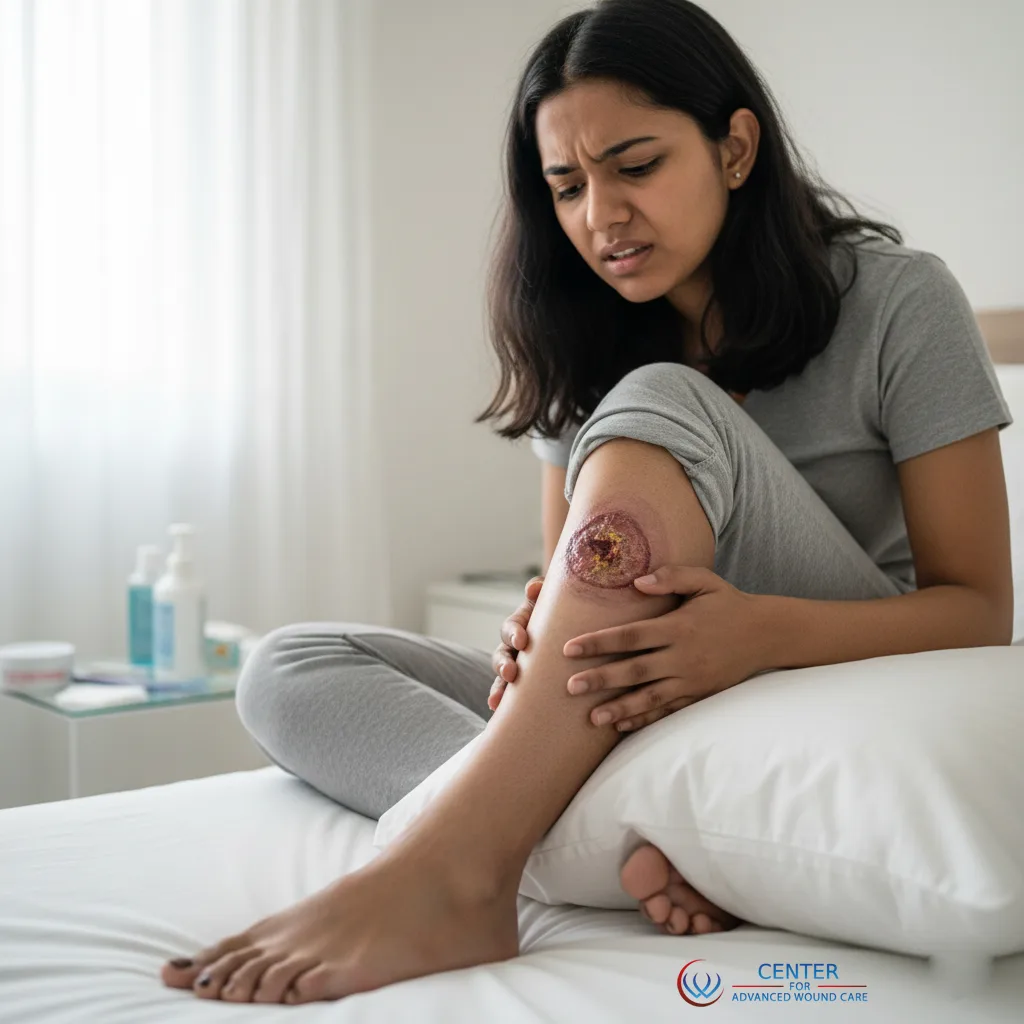
How Sarah Healed Her Arterial Leg Ulcer with the Best Treatment Options
How Sarah Healed Her Arterial Leg Ulcer with the Best Treatment Options
Table of Contents
ToggleQuick Summary:
- Restored Blood Flow – Sarah’s healing began with angioplasty, improving circulation and oxygen delivery to her leg.
- Specialized Wound Care – Her ulcer was cleaned, debrided, and dressed with moisture-balanced bandages to support tissue repair.
- Pain & Infection Control – Targeted pain management and antibiotics prevented complications and promoted faster healing.
- Lifestyle Adjustments – Quitting smoking, eating heart-healthy, and light exercise helped strengthen circulation and prevent recurrence.
- Advanced Therapies – Hyperbaric oxygen therapy and growth factor treatments further enhanced recovery and reduced future risk.
When Sarah first noticed a small sore on her ankle, she thought it was just a minor scrape. But over the next few weeks, the wound didn’t heal. Instead, it grew deeper and more painful. Walking became uncomfortable, and even resting at night didn’t ease the throbbing pain. Like many, Sarah didn’t realize she was dealing with an arterial leg ulcer, a serious condition caused by reduced blood flow to the lower legs.
In Sarah’s journey, she learned that timely treatment can make a huge difference. This story will take you through the best treatment options for arterial leg ulcers, sharing insights into how healing is possible and what steps can make a real impact.

Recognizing the Problem
Sarah’s first step was understanding what she was dealing with. Arterial leg ulcers often appear on the feet, ankles, or lower legs. They can look like deep, “punched-out” wounds and are usually very painful, especially when the legs are elevated. These ulcers are commonly linked to peripheral artery disease (PAD), where narrowed arteries reduce blood flow.
Unsure whether her sore was serious, Sarah read our guide on how to identify the early signs of arterial leg ulcers. It helped her recognize symptoms like slow healing, pain, and changes in skin color. Early awareness meant she could take action before complications arose.
Seeking Professional Help
Once Sarah decided to see a specialist, she discovered that arterial leg ulcer treatment is about more than just caring for the wound itself. Because poor circulation is the root cause, treatment must address blood flow, pain, infection risk, and overall health. Her doctor explained several options that could help her heal safely and effectively.
1. Restoring Blood Flow
The first step in Sarah’s treatment was improving circulation through revascularization. Her doctor recommended angioplasty, a procedure where a small balloon opens up blocked arteries, sometimes followed by a stent to keep them open. For patients with more severe blockages, bypass surgery may be necessary.
After her angioplasty, Sarah immediately noticed a difference. The pain eased slightly, and the wound felt warmer, a sign that blood was finally reaching the tissue. Restoring circulation is often the most critical step in how to treat arterial ulcers, because without it, even the best wound care won’t work effectively.
2. Wound Care and Dressings
With blood flow improving, Sarah’s doctor focused on the wound itself. She learned that proper care is key to healing:
- Debridement: Removing dead tissue to encourage new growth.
- Moisture-balanced dressings: Protecting the wound while keeping the skin environment optimal.
- Topical antibiotics: To prevent infection and support healing.
Sarah’s treatment plan was personalized, combining these techniques with regular monitoring to track her progress. Specialized care like this is available through our arterial leg ulcer treatment services, which ensure each patient gets exactly what they need.
3. Managing Pain and Preventing Infection
Pain was still a challenge. Sarah learned simple techniques to ease discomfort, such as keeping her legs lowered to improve blood flow and avoiding tight footwear. Her doctor also prescribed medication for more severe pain.
Because open wounds are prone to infection, her care team emphasized daily cleaning, changing dressings, and watching for warning signs like swelling, foul odor, or increased drainage. Quick action prevented infection from complicating the healing process.
4. Lifestyle Changes That Made a Difference
Sarah’s journey wasn’t just medical; it was lifestyle-focused too. She quit smoking, started a heart-healthy diet, and engaged in gentle physical activity. Managing underlying conditions like high blood pressure and cholesterol became part of her routine.
These changes, combined with her medical treatment, helped her wound gradually heal and reduced the risk of future ulcers. This holistic approach is essential in arterial leg ulcer treatment, as it tackles both the symptoms and the causes.
5. Advanced Therapies for Faster Healing
For stubborn wounds, advanced therapies can accelerate recovery. Sarah’s care team discussed options like:
- Hyperbaric Oxygen Therapy (HBOT): Breathing pure oxygen in a pressurized chamber to enhance healing.
- Growth factor therapy: Stimulating new tissue growth.
- Skin grafts: Closing larger wounds with healthy tissue.
These advanced treatments are tailored to the severity of the ulcer and patient needs, making them a powerful addition to conventional care.

Conclusion
After months of consistent care, Sarah’s ulcer finally healed. But she knew that ongoing monitoring was essential. She now inspects her legs daily, manages chronic conditions, and keeps regular appointments with her wound care specialists. This vigilance helps prevent new ulcers and keeps her legs healthy.
If you or a loved one is dealing with an arterial leg ulcer, it’s important to start treatment as early as possible. If you’re ready to take the next step, contact us today to schedule an appointment. Early intervention can make all the difference, just like it did for Sarah.
Disclaimer: “Sarah” is a fictional character created to illustrate how arterial leg ulcer treatment works. The story is for educational purposes only and does not represent an actual patient.
Frequently Asked Questions:
1. What is the fastest way to heal an arterial leg ulcer?
The fastest healing happens when blood flow is restored through angioplasty or bypass surgery, combined with professional wound care and infection control.
2. How do you treat arterial ulcers at home?
Home care includes cleaning the wound gently, keeping dressings clean and dry, avoiding leg elevation, and following your doctor’s instructions for circulation improvement.
3. What causes arterial leg ulcers?
They develop due to poor blood flow caused by narrowed or blocked arteries, often linked to peripheral artery disease (PAD), smoking, or high cholesterol.
4. Can an arterial ulcer heal without surgery?
Some small ulcers may improve with medication, wound care, and lifestyle changes, but severe cases often require procedures like angioplasty or bypass to restore circulation.
5. What are the best dressings for arterial leg ulcers?
Moisture-balanced dressings that protect the wound while allowing airflow are preferred. Your wound care specialist will choose based on your ulcer’s condition.
6. How long does it take for an arterial leg ulcer to heal?
Healing time varies depending on circulation, ulcer size, and infection risk. With proper care, many patients see improvement within a few months.
7. What foods help heal arterial leg ulcers faster?
A diet rich in lean proteins, leafy greens, fruits, whole grains, and omega-3 fatty acids helps improve blood flow and tissue repair.
8. Can arterial leg ulcers come back after healing?
Yes, recurrence can happen if circulation problems or risk factors like smoking, diabetes, or high blood pressure aren’t managed.
9. What’s the difference between arterial and venous leg ulcers?
Arterial ulcers result from poor blood flow due to blocked arteries, while venous ulcers stem from poor vein circulation and blood pooling in the legs.
10. When should I see a doctor for a leg ulcer?
If a wound on your foot or leg doesn’t heal within two weeks, or if it becomes painful, discolored, or emits an odor, you should see a wound care specialist immediately.


